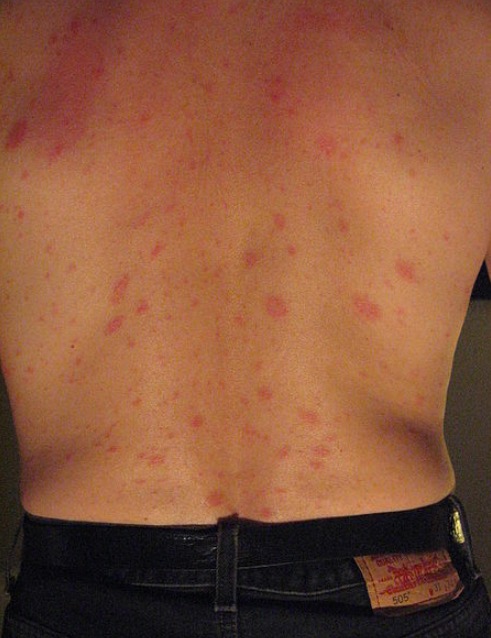Playlist
Show Playlist
Hide Playlist
Derma Case: 33-year-old Woman with Rash on Her Chest
-
Slides Fungal Skin Infections.pdf
-
Reference List Dermatology.pdf
-
Download Lecture Overview
00:02 Alright, think we're ready for case number 2. 00:05 So this is a 33-yr old real estate agent with well-controlled type 1 diabetes, presents with a rash on her chest, looks like we can also see that it's up on her neck and face. 00:15 She states that the rash developed during her recent 10-day vacation in Puerto Rico good for her! and hasn't gone away despite applying an aloe-based lotion. 00:24 People use all kinds of stuff to self medicate. 00:27 She's been using that everyday. 00:29 It's not itchy, family history's not contributory, her vital signs are all good What we find on exam is multiple, scaly, hypopigmented macules scattered along her upper chest, her neck and we can see them very clearly on her face, coalescing into some large patches. 00:47 No vesicles, and no pustules. 00:51 Alright, so which of the following is the most likely to diagnosis? We've got pityriasis rosea, seborrheic dermatitis, tinea versicolor again, vitiligo, and candida intertrigo. 01:03 So, what do you remember about pityriasis rosea? Feel free to pause the screen. 01:16 Alright, things that should come to mind immediately with pityriasis rosea are that it is non-infectious, though accompanied by some viral URI symptoms. 01:25 Don't forget about the herald patch which can precede the rest of the lesions by a few days. 01:29 The lesions you'll ultimately see are oval in shape, scaly, itchy maculopapules distributed in that Christmas tree pattern Alright. 01:41 So let's think about that in our particular patient. 01:44 So we're not getting a story of a herald patch. 01:47 That being said, she does have multiple lesions of varying sizes and shapes scattered on her upper chest and probably on her back. 01:55 but these lesions are hypopigmented rather than erythematous which is what we'd see with pityriasis rosea. 02:02 They're not itchy and she didn't describe any viral URI prodrome so I'm thinking that one's off our list, Next up, seborrheic dermatitis. 02:13 Now when you hear seborrheic dermatitis, you may often think of 'cradle cap' associated with infants. 02:19 Which we'll get to in a moment. 02:21 So Seb Derm is a chronic, relapsing, mild dermatitis. 02:25 It's of unknown etiology, we don't know exactly what causes it though there is this association with Malassezia furfur. 02:33 And as I mentioned, cradle cap occurs in infants but you'll oftentimes see it in the elderly as well and it can actually be quite severe in folks with HIV. 02:41 It's gonna be appearing on the scalp, behind the ear, the eyebrows, the blephara, nasolabial folds, and potentially on the upper chest and back. 02:52 These lesions are scaly, flaky, and one of the classic descriptive terms you'll see is 'greasy-looking' plaques. 03:01 So, these lesions may be in the right location, somewhere on the face, somewhere on the upper chest but she really is the wrong demographic for it. 03:09 She's a woman on her 30's and the appearance isn't quite right, we're not seeing these greasy plaques. 03:15 It'd be very atypical to have such a wide distribution on the upper chest and not much of other locations so I think we can safely take this one off the list as well. 03:25 Alright, another quick review. 03:27 Again, feel free to pause this screen. 03:30 What do you remember about tinea versicolor? Okay, hopefully you came up with hyper or hypopigmented patches. 03:45 Hopefully you remember that there's scale involved that may be worsened by going to tropical climates. 03:51 And the organism that's the culprit microbe is Malassezia globosa So, I think we're gonna have to keep this one on the list simply by virtue of its association with hypopigmented patches *
About the Lecture
The lecture Derma Case: 33-year-old Woman with Rash on Her Chest by Stephen Holt, MD, MS is from the course Skin Infections.
Included Quiz Questions
Which of the following skin lesions is most suggestive of seborrheic dermatitis?
- Scaly, greasy-looking plaques over the chest
- Annular, erythematous patch with overlying scales
- Salmon-colored patches with silvery scales
- Fluid-filled vesicles on an erythematous base
- Hypopigmented, scaly patches over the face
Severe seborrheic dermatitis is associated with which of the following viral infections?
- Human immunodeficiency virus infection
- Measles
- Rubella
- Herpes labialis
- Chickenpox
Customer reviews
5,0 of 5 stars
| 5 Stars |
|
5 |
| 4 Stars |
|
0 |
| 3 Stars |
|
0 |
| 2 Stars |
|
0 |
| 1 Star |
|
0 |




